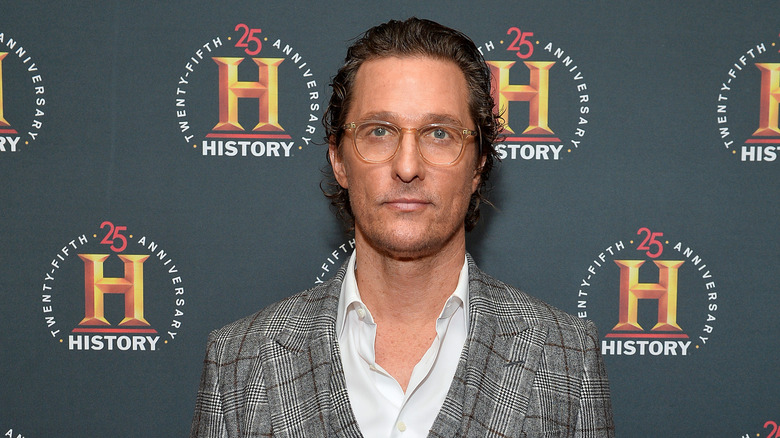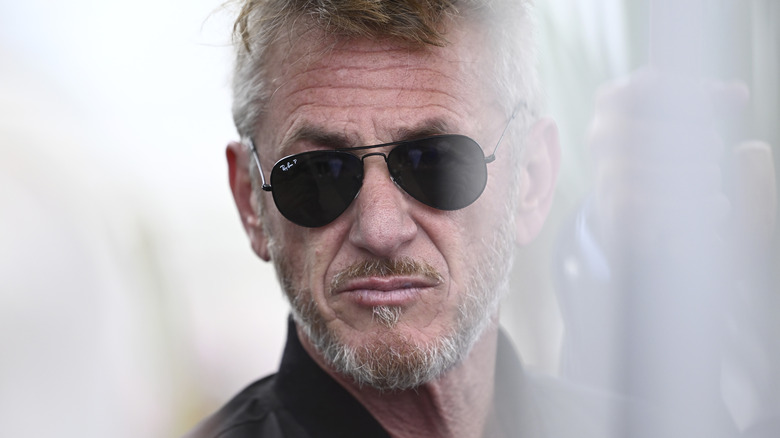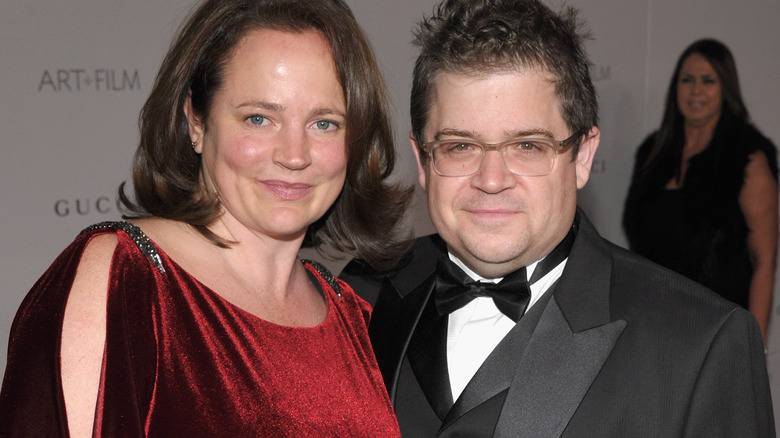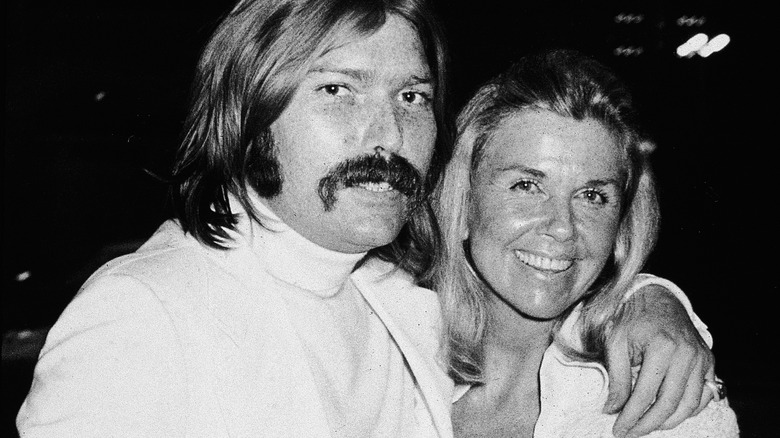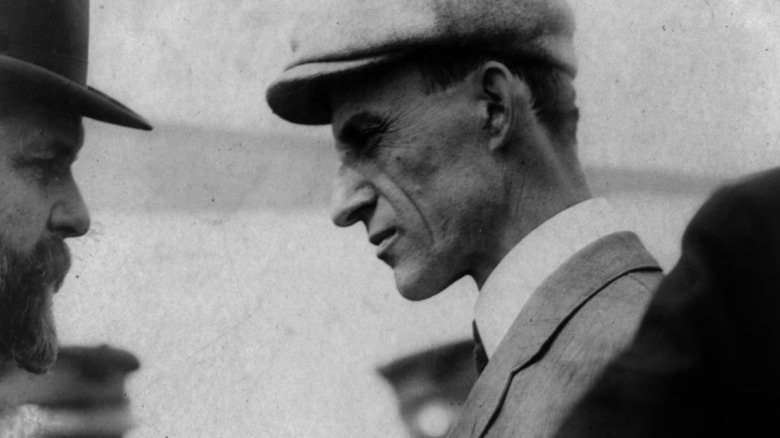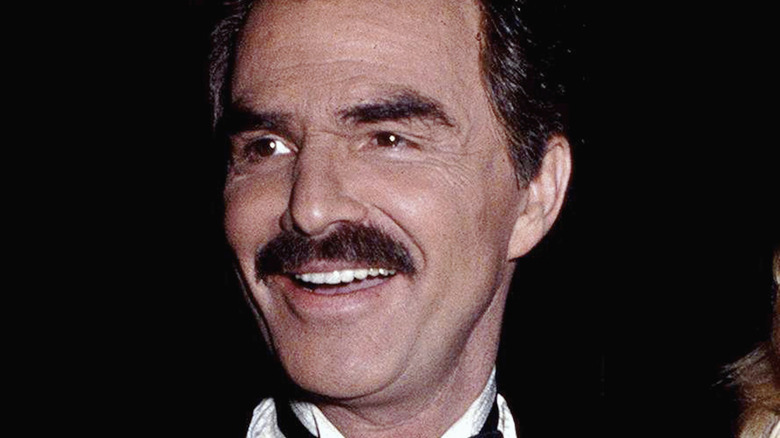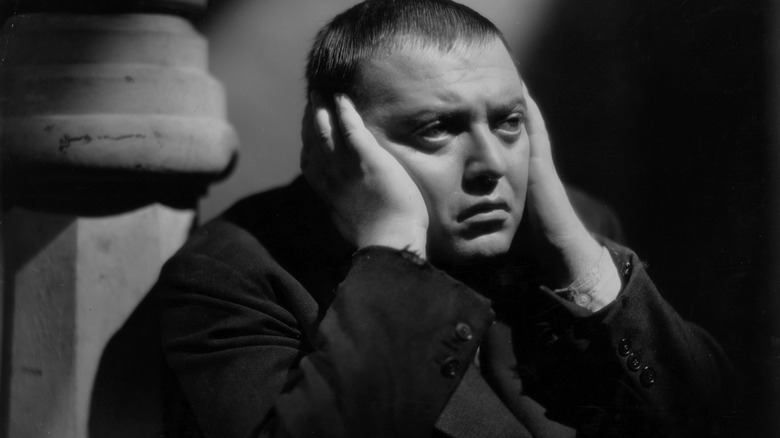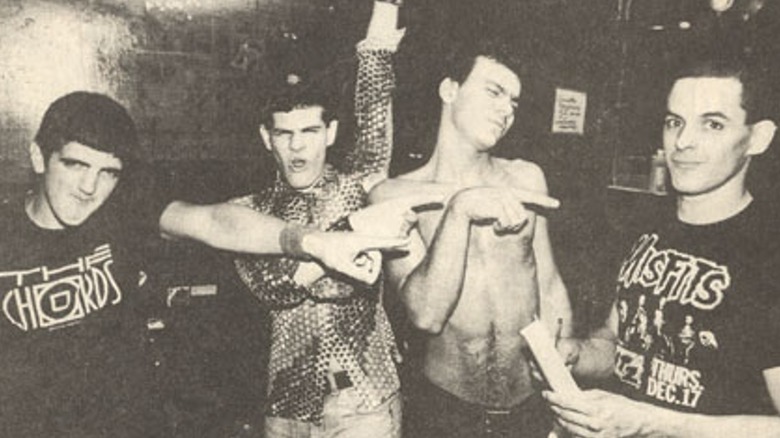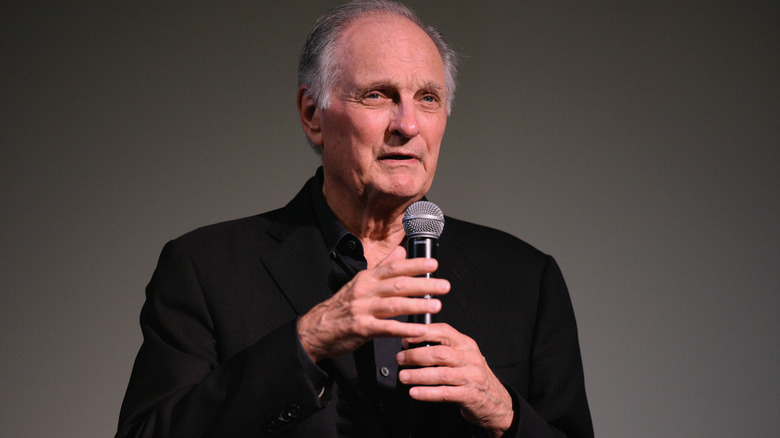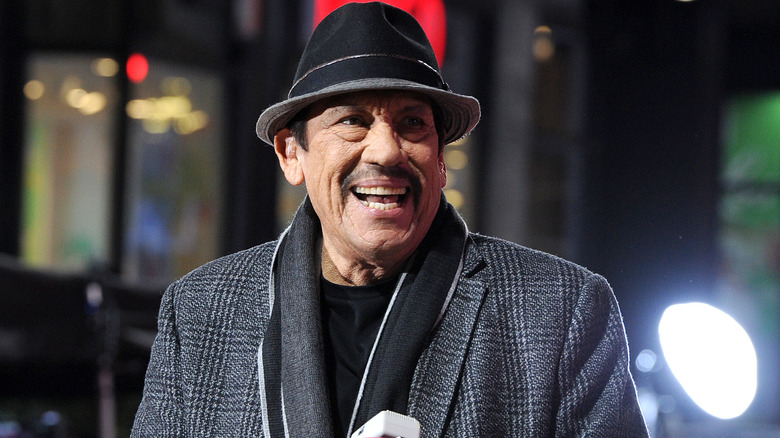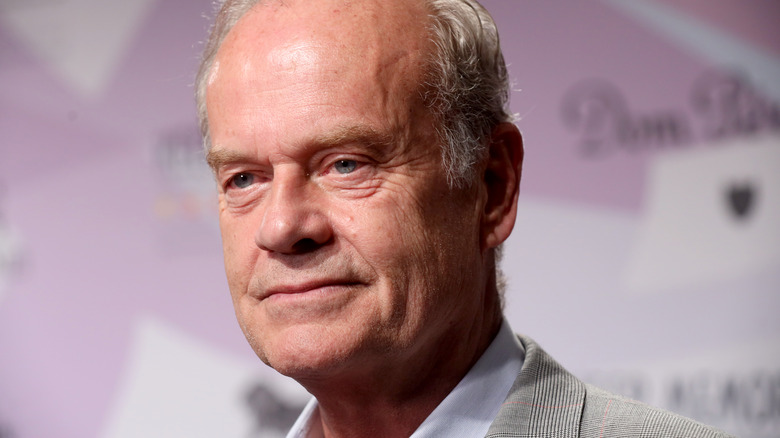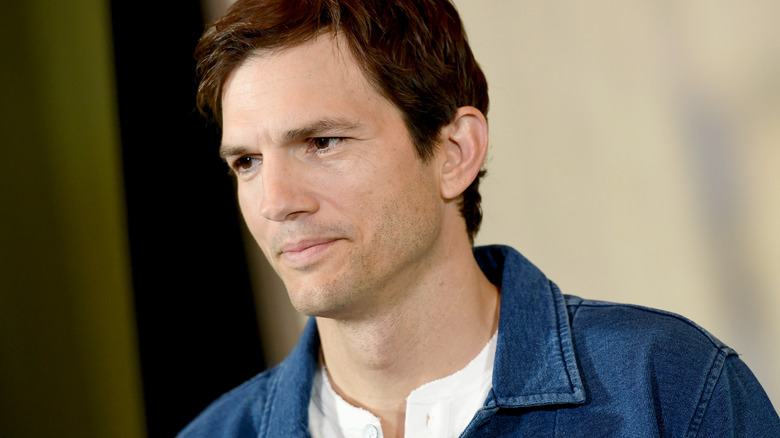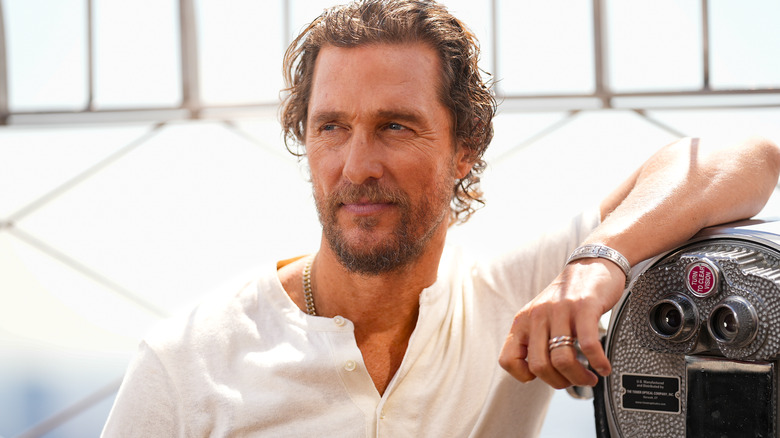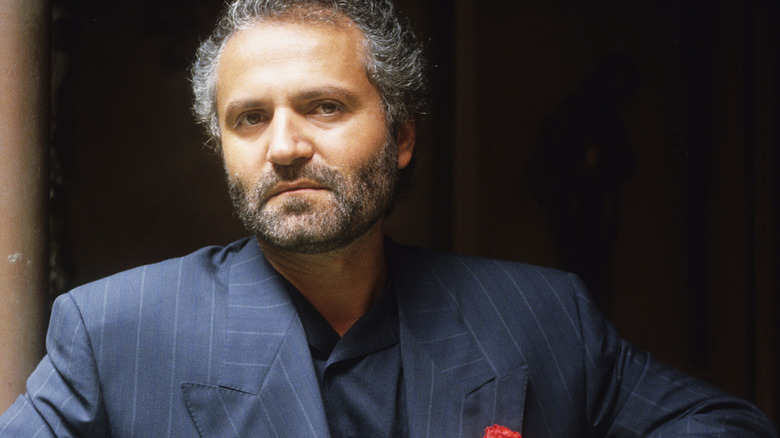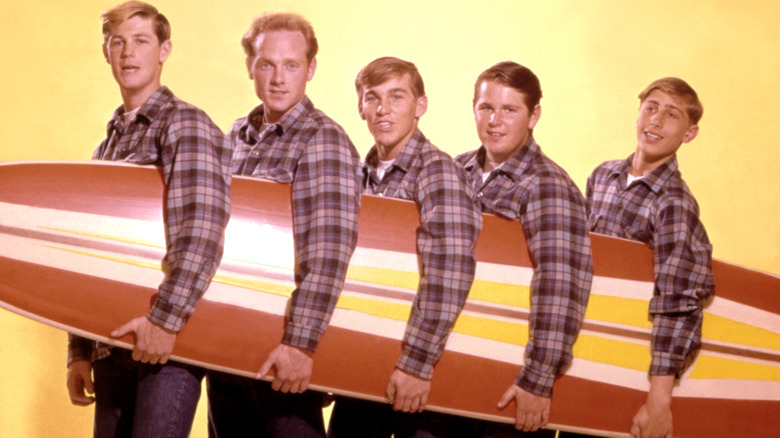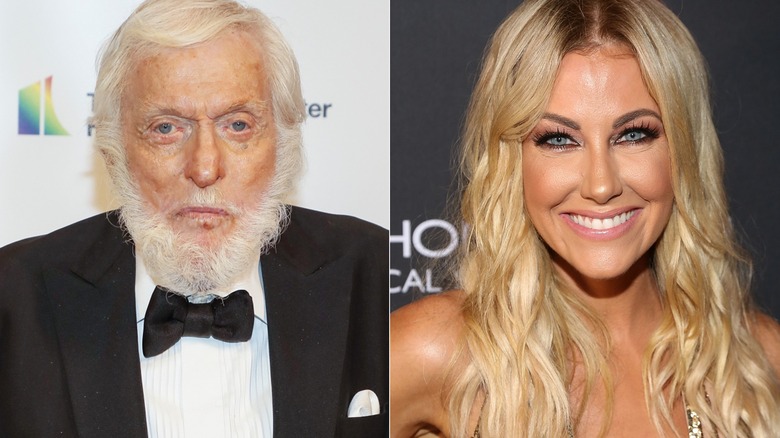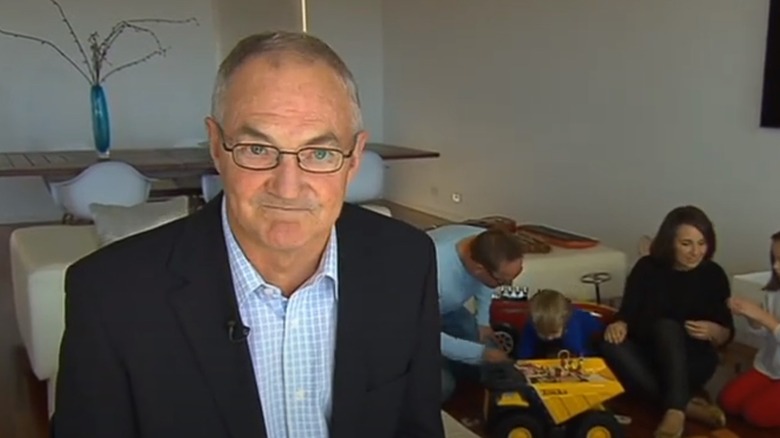Celebrities Connected To Infamous Serial Killers
It's no secret that humankind is infatuated with true crime, and serial killers are the juiciest criminals of them all ... often literally. And let's say right up front that obsession is nothing new. In the Victorian era, entire families famously gathered to watch some good, old-fashioned executions, and it wasn't long before people were cashing in: Printers were selling broadsheets commemorating crimes and executions, and even at the beginning of Victoria's reign, crowds could buy souvenirs like pottery figurines of popular killers.
Think some of the recent movies have been gratuitous? Victorians would think nothing of it ... particularly those who bought pieces of the actual barn where the notorious Red Barn Murder took place. Profiting from some of the most horrible crimes in human history came to something of an end in 1987, with the Son of Sam Laws. As the name suggests, it was enacted after David Berkowitz started getting offers from companies who wanted to buy his life story. New York State? They weren't cool with that.
It's always been a controversial thing — First Amendment rights, and all — but courts doubled down in 2023. That's when the wife of Long Island Serial Killer suspect Rex Heuermann cut a million-dollar deal for her story, and lawmakers started looking at expanding that to criminals' families. It's easy to see why victims' families might protest their loved ones' killers becoming celebrities, but here's a question: Have some of our favorite mainstream celebrities crossed paths with serial killers in a big way? Absolutely.
The following article includes allegations and descriptions of addiction, sexual assault, and suicide.
Sean Penn
Is it surprising that Hollywood bad boy Sean Penn got up close and personal with a serial killer? Perhaps not, but it is an incredibly bizarre story that started in 1987. That's when he was sentenced to 60 days behind bars and six months of therapy for a slew of offenses, including punching a movie extra.
Penn went off to jail, and who did he happen to be in a cell across from? None other than Richard Ramirez, more popularly known as the Night Stalker. Most of Ramirez's crimes had taken place in 1985, and at the time he was locked up alongside Penn, he was in the middle of a trial that would end in 1989. (He was ultimately transferred to San Quentin, and died of cancer before he was executed.) In a talk at Loyola Marymount University's School of Film & TV, Penn shared the story (via The Hollywood Reporter) of how they'd seen each other around, and it was Ramirez who reached out to him and asked for an autograph.
"So, I get this thing from him and it says, 'Hey, Sean, stay tough and hit them again — Richard Ramirez, 666' with a pentagram and a rendition of the devil." Penn's response was less gracious, reading (in part): "'I hope gas descends upon you before sanity does, you know? It would be a kinder way out.'" Penn no longer had the note — he lost it in a house fire.
Patton Oswalt
Big celebrities producing, funding, or otherwise spearheading various projects that are personally near and dear to them is nothing new, but the story of Patton Oswalt's work on the book and film, both called "I'll Be Gone in the Dark," isn't just personal, it's heartbreakingly tragic. The book was started by his wife, Michelle McNamara, and it was based on the research she'd done and documented on her "True Crime Diary" blog. The string of rapes and killings she was looking into was variously associated with a killer given names like the East Area Rapist, but it was McNamara who helped consolidate a shocking number of unsolved cases from the 1970s and 1980s, and link them to a single perpetrator she called "The Golden State Killer."
McNamara died suddenly in 2016, the victim of an undiagnosed heart condition and an accidental overdose. Oswalt picked up her book and her work, finishing it with the help of some of her colleagues. It was published in 2018, which happened to be the same year that renewed interest in the case — credited mostly to McNamara's work — led to the arrest of Joseph DeAngelo. In 2020, he confessed and was sentenced to life without parole.
Oswalt spoke with NPR after the sentencing, saying that finishing her book was as difficult as it was important. In the end, though, it was honoring her wishes and her life, with many crediting her work as making the once-cold cases impossible to ignore.
Doris Day, Terry Melcher, and Candice Bergen
Hollywood music producer Terry Melcher was famously living in a home belonging to Roman Polanski when Charles Manson auditioned for him, and when Melcher declined to sign him, everyone knows what happened next. There are still parts of the tale that are, perhaps, less well-known.
Manson had also fallen in with Dennis Wilson of the Beach Boys, and in his memoir, "Good Vibrations," fellow Beach Boy Mike Love wrote about the connection. According to him, Manson targeted 10050 Cielo Drive because he thought Melcher still lived there. Melcher, however, had moved, and Love wrote (via People): "The move was no accident. Terry, Doris [Day's] only child, was extremely close to his mom. He had told her about Manson — and about some of his scary antics, his brandishing of knives, his zombie followers — and that Manson had been to the house of Cielo and she insisted he move out. ... A mother's intuition, perhaps, and it may have saved his life."
Day's intuition may have saved Candice Bergen, too. Bergen was dating Melcher at the time, and when she spoke with the Independent in 2020 and was asked about "Once Upon a Time... in Hollywood," she said, "The feeling of it, was very close." That was partially because Manson had found where they moved to: "His mother had a house in Malibu ... where we went. Then they took the telescope off our balcony at the beach house. It was like Manson saying, 'Don't try to hide from me.'"
Wilbur Wright
Wilbur and Orville Wright may have started out in the perfectly ordinary printing business, but they became international celebrities when their research into aviation led to the development of controlled and sustainable flight. And weirdly, that might not have happened if it wasn't for a local bully-turned-serial-killer.
The Wright family was living in Ohio, and Wilbur was playing hockey during the winter of 1885/86, when he was hit in the face by another player named Oliver Crook Haugh. His injuries were catastrophic, and led to massive complications and depression that derailed his plans to go to Yale. Instead, he stayed home, opened the printing business with his brother, and the rest is history. But what about Haugh?
Haugh, too, suffered from dental problems, and became addicted to the era's medicines ... which included opium and cocaine for pain relief. He ultimately went to medical school, but his actual medical practices tended to open and close quickly amid suspicious patient deaths. It's unclear just how many there were, but Haugh was connected to the killing of multiple women while performing abortions, killing several while treating them with mineral baths, and having several girlfriends die under suspicious circumstances. He was sentenced to death for the murders of his parents and brothers, who were killed in 1905. In a story about his execution, the Los Angeles Herald reported that he maintained innocence, but that "Haugh manifested an apparent indifference to his fate until the last."
Burt Reynolds
In 1964, a serial killer stalked the streets of Los Angeles, and it was equally terrifying and weird. Nine victims were connected to the same killer, who posed them alongside cups of blood, and surrounded by salt. Bodies sported strange, ritualistic markings, and then, the killings stopped. Fast forward to 1974, though, and things kicked off again with the murder of a 46-year-old man, killed in the exact location as a previous victim.
Where does Burt Reynolds come in? Bodies had been turning up every few days for a while, when the pattern broke and two men were attacked in their Hollywood home. They fought off the intruder, who stopped at the home of neighbor Burt Reynolds as he fled. It was there that he dropped a letter that had the name "Vaughn Greenwood" on it, and Greenwood was arrested shortly afterward. Reynolds was later called to testify as a witness for the prosecution, and Greenwood was convicted of both the assaults on the two men and nine counts of murder. Along with his life sentence was a recommendation that he never be eligible for parole, with the judge noting (via "The Encyclopedia of Serial Killers"), "This presence in any community would constitute a menace."
In an interesting side note, the Greenwood case is one that's sometimes cited as an instance where profiling has been incredibly wrong. Greenwood's ultimate capture was considered not a matter of diligent police work, but chalked up to a fortunate accident involving Reynolds and a dropped letter.
Bryan Cranston
Want to stay away from serial killers? Maybe don't hang out with Bryan Cranston. He was on The Dan Patrick Show when he talked about meeting Charles Manson as a pre-teen, while out horseback riding with his cousin. They frequently headed out into the wilds north of LA, near Manson's Spahn Ranch. Cranston said that they were getting their horses when someone ran in screaming about Charlie, sending everyone there into a frenzy. He said that he went on with his ride, and within minutes passed the group, now returning with one terrifying individual in the center.
Cranston described Manson's "dark, dead eyes," saying that he was on a horse but being led by someone else. "He was just out of his mind," Cranston recalled, adding that after he saw the guy, "We didn't think another thing of it." Until, of course, the news. He added: "I'll never forget that face."
Creepy? Definitely, and Cranston also has a connection to Clifton Bloomfield. Bloomfield was convicted of the 2008 murder of Scott Pierce, the 2005 murders of Tak and Pung Yi, and two other murders in 2005 — the killings of Carlos Esquibel and Josephine Selvage. Bloomfield also made some appearances as a movie and television extra — and yes, he was absolutely in "Breaking Bad." (Even more bizarrely, Cranston was on "The Tonight Show" when he shared a story about how he and his brother were flagged as murder suspects after the murder of their former boss, which happened just before they left town.)
Peter Lorre
Peter Lorre was one of the great actors of his era. Would "The Maltese Falcon," "Casablanca," or "Arsenic and Old Lace" be the same without him? Lorre died tragically young, passing away in 1964, when he was just 59 years old. So what, exactly, did he have to do with a pair of serial killers who terrorized Los Angeles in 1977?
Angelo Buono and cousin Kenneth Bianchi became known as the Hillside Strangler, and they definitely had their methods down to a science. After picking up their victims and taking them to Buono's home, the pair would rape, torture, and strangle them before leaving them in easy-to-spot locations around the city. Ten women died before the pair split up, and when Bianchi started killing in Washington, he was finally arrested. Loyalty to his former partner didn't count for much, and he made a deal to flip on his cousin in exchange for taking the death penalty off the table. As of early 2024, he's still in jail. (Buono died in 2002.)
The connection? This one comes courtesy of The Humphrey Bogart Estate, who shared the story in a social media post. Lorre had one daughter, named Catharine, and she nearly became one of the Hillside Stranglers' victims when she caught Bianchi's eye. It was only when she name-dropped her father that they decided to let her go.
Dave Rubinstein
Dave Rubinstein was one of the founders of hardcore punk band and CBGB's mainstay Reagan Youth. Famous — or perhaps more accurately, infamous — for their KKK- and Nazi-inspired look alongside definitively anti-fascist messages, they were once one of the biggest hardcore punk bands on the East Coast ... until things went terribly wrong. The band's initial run ended when Rubinstein died by suicide, and when fellow Reagan Youth member Paul Bakija decided to get things back together in 2013, he explained his motivations (via the Chicago Tribune): "I hated the way the band ended. I wanted to change that ending, ... and maybe it'll give Dave a different ending."
Bakija is talking about the death of Tiffany Bresciani, who was involved with Rubinstein when she was brutally murdered by notorious New York serial killer Joel Rifkin. Bresciani would be the last of his victims: After wrapping her in a tarp and storing her in his mother's garage for several days, Rifkin attempted to dispose of her body. When law enforcement spotted his missing license plate, he tried to flee, crashed instead, and was arrested when her body was discovered. He would ultimately confess to killing 17 people.
Rifkin's confession came on June 28, 1993, and in a completely horrible footnote to this story, it was only a few days later that Rubinstein's father killed his mother in what was considered a freak automobile accident. Rubinstein's death — ruled an intentional overdose — happened just days later, on July 3.
Alan Alda
This particular story starts with a 1970s-era game show called "To Tell the Truth." Simply put, a panel was presented with three contestants, and had to ask questions to determine which one of them was telling the truth about a particular scenario. In the case of one episode that aired in 1973, panelists — including actor Alan Alda, opera singer Kitty Carlisle, actress Peggy Cass, and "Match Game" host Gene Rayburn — were tasked with figuring out which of three men was really Ed Edwards, author of the memoir, "Metamorphosis of a Criminal."
The book detailed how the author went from a life of petty crime, escalating to a place on the FBI's Most Wanted List, to being a respectable family man. Rayburn and Cass were the only two to correctly identify the third contestant as Edwards, but there is, of course, more to the story.
Fast forward a few decades, to April Balascio. The daughter of Ed Edwards, she'd always had a bad feeling about her father — particularly about the strange way they'd suddenly and randomly pull up roots to move. She told People, "He'd tell us that we had to move in secret because he was protecting us, because there were people who wanted to hurt him or us." The truth was that he was connected to at least five murders, including two couples and his own son. After stumbling on the discovery, Balascio called authorities. Edwards died in prison in 2011, two years after he was arrested.
Danny Trejo
The problem with making Danny Trejo's life into a Netflix series is simply that no one would believe that it's been such a wild ride — and that includes the time Charles Manson hypnotized him while they were in jail together. He wrote about the encounter in his memoir, "Trejo," and taken alongside the fact that Manson convinced his whole Manson Family to do some seriously terrible things at his request, it's an eerie tale.
Trejo wrote (via Far Out) that when he was 17 years old, he found himself in jail alongside a "dirty greasy scrawny white boy [who] was so poor, he didn't have a belt, and instead used a piece of string to keep his pants up. I felt sorry for him. It was clear the only shower the man was ever going to have was the one he was going to get in jail." He went on to say that Manson had claimed he could take them on a guided meditation trip, that would mimic what it felt like to shoot up with heroin, and not only did he talk them through it, Trejo said that he was terrifyingly good at it.
"If that white boy wasn't a career criminal, he could have been a professional hypnotist," Trejo wrote. By the time Manson guided Trejo through the meditation, he had been using heroin for three years, and he wrote that he had a physical response to Manson's words. Eerie? Absolutely.
Kelsey Grammer
In 2022, Kelsey Grammer spoke with People in an interview that touched on the decades-old murder of his sister, Karen. "I've been writing a book, actually, about some of the past, and one sentence comes to mind: 'It was the ancient grief that is forever fresh.' It's always with you," he explained. Karen Grammer was killed in 1975, after being abducted, sexually assaulted repeatedly, and stabbed repeatedly. Her body was found the following morning, where she'd fallen as she tried to find help.
Three men were arrested and convicted of the murder — Freddie Glenn, Michael Corbett, and Larry Dunn. Glenn is the only one still alive, and still serving a life sentence in a Colorado prison. There are more victims, too — and Glenn was behind the wheel for several of them.
That included the death of Daniel Van Lone, shot and killed after an attempted robbery, and Winford Profitt, who was stabbed because Corbett just wanted to know what it was like. Glenn dropped out of the killing after Grammer's murder happened next, but was arrested along with Corbett when he was linked to several more killings. Glenn has been up for parole several times, stating (via Westword), "I stabbed Ms. Grammer. I accept full responsibility and hold myself accountable for the death of Ms. Grammer. I do.'" At other times, he's maintained his innocence, and even though Kelsey Grammer says he forgives Glenn, he has continuously campaigned against his release on parole.
Lisa Rinna
David Carpenter was arrested as the Trailside Killer, convicted of murdering multiple victims in the late 1970s and early 1980s. His preferred hunting ground was along the hiking trails in several California counties, giving him his moniker. In 2010, it was announced that DNA evidence had connected him to yet another victim, a 23-year-old woman who had been stabbed around 25 times. His serial killing spree wasn't the first time he'd wreaked havoc on those around him.
Carpenter was arrested, tried, convicted, and sentenced to seven and a half years in jail in 1960, after he attacked a woman named Lois Rinna. Rinna's story was relayed on an episode of "The Real Housewives of Beverly Hills," which features her daughter, Lisa, among the cast members. She explained that the Rinna family had been friendly with Carpenter's family, so when he offered her a ride, she didn't think anything of it. She said (via People): "That was a really bad thing. I knew him. I thought that was it. He's straddling me. He had a hammer in one hand and a knife in the other."
After being stabbed and hit with the hammer, a military police officer intervened. He'd seen them heading down a deserted road and suspiciously followed, reaching them in time to save Lois's life. Lisa added her own thoughts (via Elle), saying: "I had such great sadness and empathy for my mom ... She never dealt with it. She never even talked about it."
Angela Lansbury
In 2014, Angela Lansbury sat down with the Daily Mail, and looking back at the moments that shaped her life, she cited the death of her father as one of those moments. She was just 9 years old when he passed away after being diagnosed with cancer, and it would ultimately lead to the family packing up and moving to Los Angeles. And that would later bring her into the orbit of one of the most notorious figures in American history.
Lansbury had a famously long marriage to Peter Shaw, and in the 1960s, they discovered that their children had fallen in with something that might loosely be described as "not very nice people." Lansbury explained: "It pains me to say it but, at one stage, Deirdre was in with a crowd led by Charles Manson. She was one of many youngsters who knew him — and they were fascinated. He was an extraordinary character, charismatic in many ways, no question about it."
Knowing that the whole thing was just a recipe for disaster, Lansbury and Shaw uprooted their family and moved to Ireland, where they helped both children get into treatment for heroin addiction. At the time, she said they were more concerned about the drugs than anything else that might have been going on, but Lansbury added, "It fills me with dread. ... I have no doubt we would have lost one or both of our two if they hadn't been removed to a completely different milieu."
Ashton Kutcher
When Ashton Kutcher took the stand in a Los Angeles courtroom in 2019, he told a horrifying story. He'd arranged to meet Ashley Ellerin for a date, and when he showed up late to her place, there was no sign of her. The only thing out of the ordinary that he said he saw was (via The Guardian) "what I thought was a red wine spilled on the carpet." It absolutely wasn't wine, and the following day, Ellerin's roommate discovered her body. A later examination revealed that she had been stabbed 47 times.
Ellerin was killed in 2001, and it wasn't until 2021 that Michael Thomas Gargiulo was sentenced to death for not only her killing, but the 2005 murder of Maria Bruno, and the 2008 attempted murder of Michelle Murphy. Not technically a serial killer? Hold that thought, because he was also facing a trial in Illinois for killing a woman named Tricia Pacaccio.
Gargiulo maintained his innocence throughout, condemning his own attorneys for not letting him take the stand even though he wanted to defend himself. He claimed (via The Guardian), "I'm going to death row wrongfully and unjustfully," while those who spoke at the sentencing hearing were honest, open, and forthright about the devastation they still felt decades later. Ellerin's father, Michael, had seen his daughter just hours before she was killed, saying, "It marked the beginning of an altered, diminished, heartbreaking life."
Matthew McConaughey
When Edward Harold Bell died in 2019, the details of the only crime he was convicted of were lurid enough. Bell was already a convicted sex offender when he shot and killed a former Marine named Larry Dickens, after Dickens made it quite clear that he wasn't going to stand for anyone sexually harassing neighborhood girls. Even though Bell was immediately arrested, he posted bail and disappeared for 14 years ... until he was recaptured just days after the airing of an episode of "Unsolved Mysteries," in which Larry Dickens was played by none other than Matthew McConaughey.
It actually took just 11 days for Bell to be re-arrested, which is incredibly impressive — especially considering he had been living in Panama. The Radio Times quoted an interview with McConaughey, in which he said, "I was like, 'Oh, my God! Somebody saw the show I was in!'"
Bell was given a 70-year sentence for the murder, and while he was in prison, he confessed to being responsible for the deaths of what he called the "eleven who went to Heaven." His other victims varied in age and were as young as 12 years old, but at the time of his death, the 11 murders were still considered cold cases. Still, investigating officer Michelle Sollenberger from the Galveston Police Department said (via the Houston Chronicle), "Today these girls may finally rest in peace because their killer has gone to hell."
Gianni Versace
Gianni Versace was killed in 1997, and decades later, exactly why Andrew Cunanan felt the fashion designer had to die is still unknown. Given that Cunanan himself died by suicide after the high-profile murder, it's probably safe to say that no one will ever come up with a definitive motive.
What is known is that Versace — a favorite designer for celebrities from Princess Diana to Courtney Love — wasn't Cunanan's first victim. He wasn't even the second, third, or fourth, as he had already been linked to the bludgeoning death of 28-year-old Jeffrey Trail and the shooting death of 33-year-old David Madson, both in Minnesota. Then, he moved on to Chicago, where he stabbed and killed 75-year-old Lee Miglin. From there? His next victim was William Reese, a 45-year-old cemetery caretaker in New Jersey.
Countless attempts have been made to make some sort of sense of exactly who Cunanan really was, and why he executed Versace on the steps of his Florida home. But as Vanity Fair found when they tried tracing his steps and interviewing those who knew him best, even those closest to him didn't really know him: He was a serial liar fond of telling tales — the taller, the better. What they did find is a slew of acquaintances who admitted that, in hindsight, they probably should have reached out to someone sooner: Tom Eads summed up their thoughts with, "It breaks my heart. None of us could see it, or wanted to see it, or wanted to help. I feel a lot of guilt."
Dennis Wilson and Mike Love
It started pretty innocently enough, with the Beach Boys' Dennis Wilson (center) spotting two female hitchhikers and giving them a ride. No good deed goes unpunished, the saying goes, and Wilson soon found that the women not only were opting not to leave his house, but that they'd brought along their so-called "spiritual guru." That, of course, was Charles Manson.
Initially, the relationship seemed mutual. They shared drugs and women, but when Wilson's connections failed to make Manson's musical dreams come true, things soured to the point where Wilson moved out of his own home ... after Manson and his followers had spent somewhere around $100,000 of his money. Things cooled off a bit, and the story of how the Manson family killings played out is pretty well-known by now.
Fellow Beach Boy Mike Love (second from left) wrote about the bizarre meet-up in his memoir, "Good Vibrations" (via Biography). He claimed that Wilson had always felt there had been something more he could have done to stop the events that played out, and that's not the only weird thing here. Love also wrote (via People) that at this point, he and his wife had divorced, in part because she was hooking up with Wilson on the side. After they split, they shared custody of their two kids ... who would occasionally be left in the care of Susan Atkins. And yes, she's the one who left a message — "PIG" — written in Sharon Tate's blood.
Dick Van Dyke and Stephanie Hollman
The so-called I-5 Killer had a full spread dedicated to him in Sports Illustrated. Why? Randall Woodfield was drafted by the Green Bay Packers out of Portland State University, and if it had been a later decade, a background check might have caught things like an indecent exposure arrest that happened while he was in college.
It wasn't caught, and Green Bay offered him a deal. All seemed well, until he was cut from the team for unspecified reasons. He drifted for a while, was eventually caught attacking women, was arrested, and ended up in jail. Fast forward to 1980, and the first victim that would ultimately be attributed to him was raped then killed by both blunt force trauma and stabbing. By the time he was arrested and tried, he was connected to more than a dozen victims, including a 14-year-old girl.
In 2021, "Real Housewives of Dallas" star Stephanie Hollman dropped a shout-out to the I-5 Killer in her Valentine's Day Instagram post to her husband, Travis. In it, she said, "You are the only person I have ever met who was babysat by a serial killer and made it out alive (true story he was babysat by the 1-5 (sic) killer." Yikes? A little bit. And as for the Dick Van Dyke connection? When Woodfield went to trial for some of the most brutal crimes of the decade, he was prosecuted in Oregon's Marion County. The prosecutor? Chris Van Dyke — Dick Van Dyke's son.
Rob Kelvin
Let's head down to Australia and tell the tragic story of one of their most beloved news anchors. When Rob Kelvin retired in 2010, it was after 32 years of reading the Channel 9 news. He was a part of the news in 1983, when his son Richard Kelvin was abducted, drugged, sexually assaulted, and killed after being held in captivity for five weeks.
Richard Kelvin was 15 years old when he disappeared, and in 1984, Bevan Spencer von Einem was convicted of the killing and given a 24-year sentence without the option of parole. Although Richard is the only victim von Einem was connected to, he's only part of the story ... and so is von Einem.
Von Einem and Kelvin are a part of what's been called the Family Murders, and it's gruesome stuff. Crime writer Debi Marshall says (via the Herald Sun) that there are as many as 150 unsolved murders — most of young men — that have been attributed to a group of an indeterminate number of men — usually said to be five or six — that included von Einem. He, however, hasn't been talking, but Marshall has succeeded in overturning what's called a suppression order. That's a gag order on persons of interest, and when Marshall spoke with one, he claimed that von Einem was often seen in the company of young boys he drugged then assaulted. Dozens and dozens of victims, says News.com, are connected by the cause of death: "massive blood loss from anal injuries."
If you or anyone you know needs help with addiction issues, has been a victim of sexual assault, or is struggling or in crisis, contact the relevant resources below:
-
The Substance Abuse and Mental Health Services Administration website or contact SAMHSA's National Helpline at 1-800-662-HELP (4357).
-
The Rape, Abuse & Incest National Network website or contact RAINN's National Helpline at 1-800-656-HOPE (4673).
-
Call or text 988 or chat 988lifeline.org
